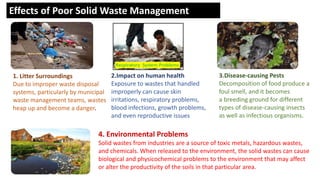The document discusses solid waste management. It defines solid waste and describes its various sources such as residential, commercial, and industrial areas. The types of solid waste are categorized and examples are provided. Improper management of solid waste can lead to negative environmental and health impacts. Methods of solid waste treatment include reduction, reuse, recycling, composting, landfilling, and incineration. Laws governing solid waste management in India are also outlined. Overall, the document provides a comprehensive overview of solid waste, its impacts, and management approaches.






















